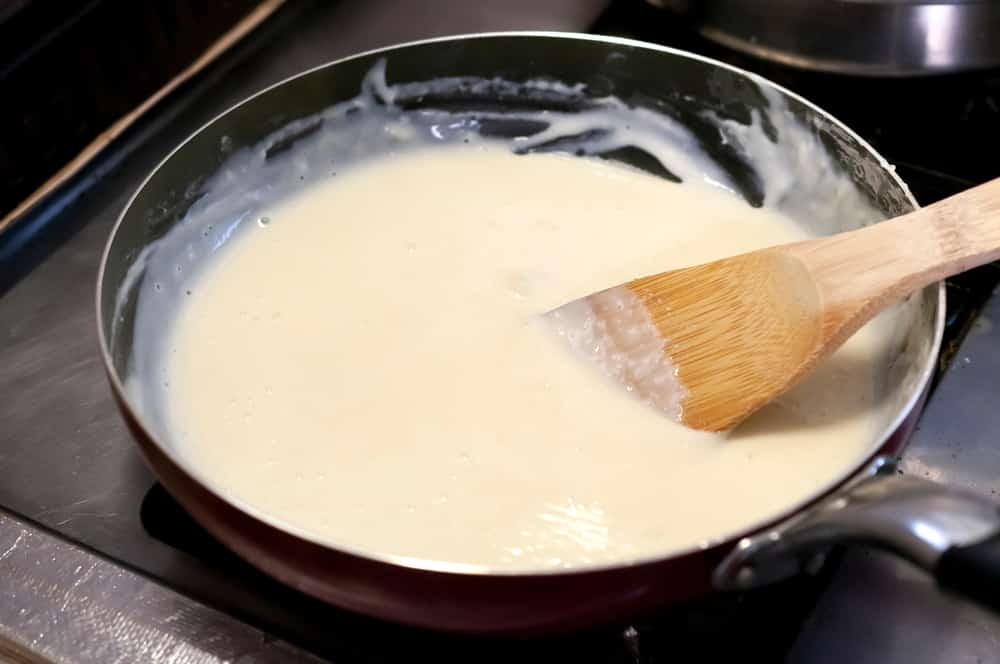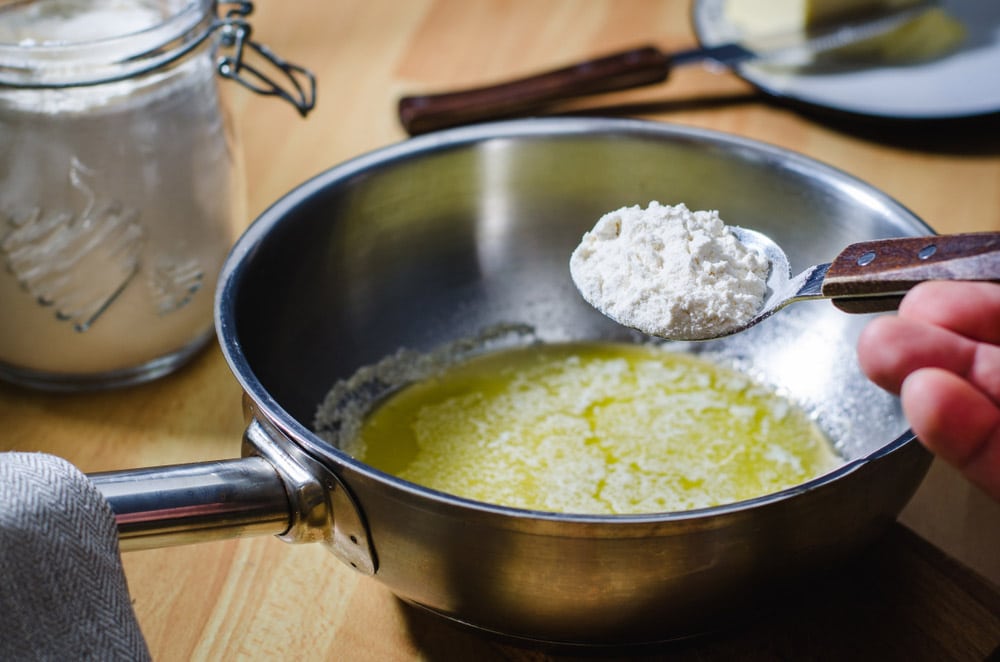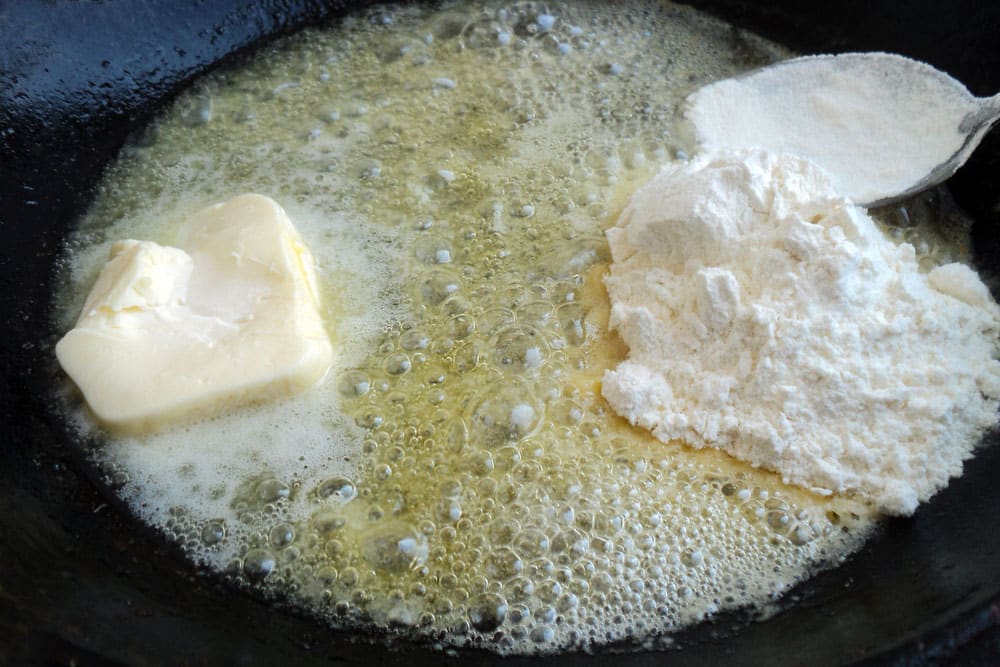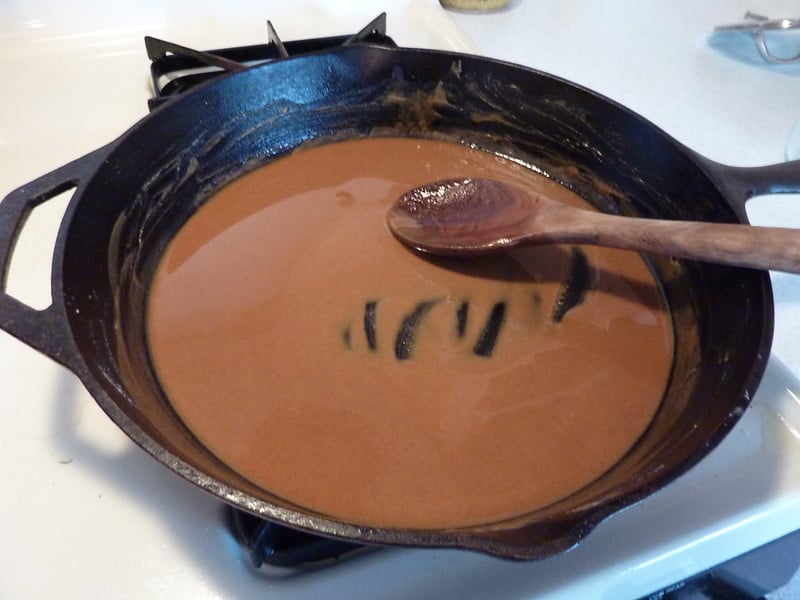
Roux (pronounced Roo), is a traditional thickening agent. The French use roux in their cuisine, with it forming the base for many foods such as sauces, gravies, stews and soups. It’s made with an equal amount of fat and flour, with the equal parts being measured by weight and not volume.
Roux thickens a liquid by the starch molecules absorbing it and expanding, causing it to become gelatinous. It’s the fat that helps to keep the starch molecules separate so that they don’t clump up.
Whether you use roux as a thickening agent or to add flavor, the white and brown shades of the roux will add wonderful aromas and flavors to your food. The longer you cook roux, the darker it becomes, with the darker roux’s having less thickening properties than the whiter roux.
Whether your sauce turns out white or brown, It’s no joke when you’re preparing supper for guests and your sauce isn’t thickening. Then you have to be quick with taking steps to resolve your roux not thickening.
Let’s first take a look how you would make a brown roux.
- Melt 1 part butter in a pan over low to medium heat.
- Sprinkle in 1 part flour. Some people use cornstarch.
- Stir the butter and flour with a wooden spoon.
- In a matter of 3 to 5 minutes, you’ll have a light roux.
- Continue stirring and cooking the roux, and after 7 minutes of cooking time, it turns brown, and you have a brown roux. If you want the roux to be a darker brown, allow it to cook longer, possibly 12 to 15 minutes.
- Cool the roux before adding a liquid such as milk or stock, and use a whisk while you simmer to the thickness you want.
Roux Not Thickening
This is a pretty fool-proof way to make roux, but what happens when, for some unknown reason, your roux isn’t thickening. How do you resolve the issue of roux not thickening?
- You add in more flour
Yes, the recipe to make roux calls for flour, but chances are you’ve ended up with a thin, runny sauce. The amount of flour you use in your roux will determine the texture and consistency of the sauce. When a roux sauce goes wrong, it can still be fixed by making it thicker.
The most widely used sauce-thickener is flour. If your roux is too thin, try adding a slurry. A slurry is made up of flour, water, and sometimes butter, all mixed together to form a paste. A good idea is to always go with a one-to-one ratio of flour, water, and butter.
Mix it thoroughly so that the sauce is smooth, and add it to the watery roux. Stir thoroughly over heat until you see it thickening. Season with salt, pepper, and celery.
- Temperatures to be moderate
Roux can be white or brown, depending on the heating temperature. The color of roux turns from white to brown with higher temperatures. Cooking at different temperatures affects the ability of roux to thicken a sauce. Cooking time is critical to the quality of a roux.
When you prepare roux at the correct temperatures, you will notice that it puffs up. To make your roux, use a medium heat throughout while constantly stirring and watching that it doesn’t burn.
Roux can be added to a sauce either warm or cold, but it should never be boiling hot. The reason for this is that a hot roux will separate when it comes into contact with a cold sauce, causing lumps and also the loss of the roux’s thickening power.
Cooking experts tell us that to avoid lumps in your roux, the idea is to always whisk a cold liquid, such as chicken stock or milk, into the warm roux and to do it slowly.
- Get your techniques right
A sauce is made of three ingredients: – thickening agent, flavorings, and liquid. It’s the liquid that provides the body of the sauce, and flour and milk form the base of a roux or white sauce.
We’ve all seen flour turn lumpy when mixed with milk, and when it comes to adding in liquids, the timing, volume of ingredients, and ways you stir can all work to prevent roux and sauce disasters.
So when making roux, you need to get several techniques right to help it turn out smooth and have the perfect texture. Once your roux has been added to the liquid you wish to thicken, whisk thoroughly while bringing the sauce to a simmer.
You can simmer for 15 to 20 minutes. Keep in mind that the longer the roux cooks, the more runny it becomes. A typical roux contains protein, fat, starch, and moisture, and the components in the ingredients influence the thickening ability of the roux.
If you’re only wanting a cup of sauce, for example, you can use 2 tablespoons of butter and 2 tablespoons of flour. As suggested, roux is made by cooking equal parts of flour and fat. Butter is the most commonly used fat, but a delicious idea is to make roux with bacon fat.
Conclusion:
If a sauce is disappointingly thin, the problem stems from your roux being too thin. Maybe you didn’t add enough flour. Fortunately, there is a quick fix to your roux-not-thickening problem. The best way to fix your runny sauce is to make a quick slurry and whisk it into your sauce.
Make sure to give it enough cooking time after adding it to get rid of that raw flour taste. You can always make a larger batch of roux and freeze it to use later. Having a cooked and prepared roux in your freezer saves time when you want to make a sauce or soup.
Store it in an airtight container. A well-prepared roux is just the start to preparing the glorious sauces, soups, stews, and gravies that you have in mind to create.




Just a memory I thought I’d share. This brings us laughs every Thanksgiving at my expense. I was making gravy for our meal and indeed it was NOT thickening. I kept adding more flour and it wasn’t thickening it at all. After wondering how all that “flour” could possibly have done nothing, I realized I was using 10X sugar! Now I keep them separated in the kitchen.